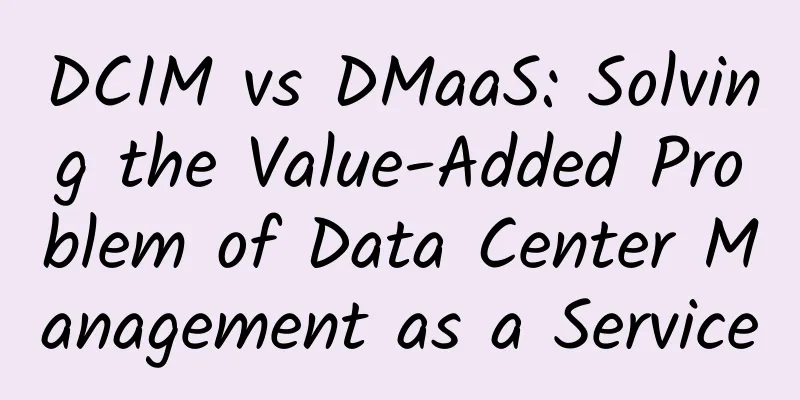DCIM vs DMaaS: Solving the Value-Added Problem of Data Center Management as a Service

|
Despite the adoption of data center infrastructure management (DCIM) software by many enterprises, there has not been much progress in management. DCIM improves data center operational efficiency through service level agreements, transparency and reporting support. But there are still some areas where data centers can be strengthened to gain wider adoption. Key Benefits of DCIM Today, no one doubts the many inherent benefits of DCIM. Enterprises that correctly apply DCIM solutions can save time and money, reduce manpower waste, and improve productivity. DCIM tools bring many benefits to data center managers, avoiding the need for staff to identify assets on site, reducing the need for space asset occupation, or eliminating the need to consume power and cooling resources at specific times.
Data center staff can access accurate real-time data through a laptop or desktop using DCIM. DCIM provides them with a window into key asset details, including physical power and network connections. DCIM tools help identify critical path nodes, thereby reducing the risk of failure to an acceptable level, which is very useful for accurate capacity planning. It can make retention, movement, addition, and change go smoothly. Even staff efficiency and morale will improve due to better workflows achieved with DCIM. Many data center managers rate DCIM as passable but not excellent. The reason is simple: deploying DCIM is still a challenge for many enterprises. Some companies do not even adopt commercial standard DCIM products, but customize them to meet their specific needs. In addition to being a software product, DCIM is a process that involves working with multiple groups within an organization (typically facilities, data center, and IT). Implementing a DCIM solution means working with teams from different areas of the organization. When working together, managers must define the processes to be managed by the DCIM solution and ensure that the data currently available is accurate. This means doing the heavy work of setting up SNMP community strings and Modbus registers, as well as IPMI usernames and passwords to poll the data center for survey data. It is also important that the DCIM solution collects data from legacy hardware using existing, often undocumented protocols. Accelerating the implementation of a DCIM solution means completing all the steps to determine the unique needs of the data center, evaluating possible solutions, and arranging a "proof of concept" to verify that the selected solution meets the needs of the data center environment. Value-added services of Data Center Management as a Service (DMaaS) Data Center Management as a Service (DMaaS) emerged in the second half of 2016. It differs from DCIM tools in that it can collect and analyze data from a wide variety of clients that are widely distributed in different data centers. The key idea is the ability to apply statistical analysis of big data. This is extended by machine learning and other forms of artificial intelligence, especially with predictive capabilities. The statistical analysis advantages of DMaaS are being accepted by data center and IT managers because the investment in DCIM platforms deployed in data centers can now be transferred to cloud computing services. DMaaS can ultimately accurately predict and prevent incidents and failures in data center infrastructure. With the help of DMaaS tools, data center inefficiencies and insufficient capacity can be effectively alleviated. This cloud-based, vendor-agnostic software-as-a-service architecture will drive the future development of data centers, edge computing, and hybrid clouds. In contrast to DCIM delivered on-premises and SaaS, DMaaS aggregates and analyzes anonymous data that can be opted in through machine learning. Its value-added service is that DMaaS combines cloud-based monitoring with maintenance and repair services, which is a boon for suppliers. Not to be overlooked, DMaaS is easy to adopt, allowing for baseline and benchmarking of similar data centers. Its automation and monitoring benefits appeal to IT and DevOps technicians who appreciate easy and instant access to large amounts of collected data. The analysis of this data collected from various cloud platforms constitutes a pivot point for leveraging the key benefits of machine learning and increasing cloud computing knowledge. With DMaaS, staff can access data from anywhere, meaning managers do not need to be on-site or rely on VPNs to assess risks or add the right people to solve problems. The strengthening role of artificial intelligence Cloud-based AI-driven management software can seamlessly monitor and control data center infrastructure for IT and facilities, including applications across multiple sites. AI is a technology that effectively controls, monitors, and regulates power, cooling, computing, workloads, storage, and networking to optimize efficiency, productivity, and availability. Cloud-based analytics will use sensor data from multiple data centers to guide and implement preventive maintenance plans. Intelligent robots will order, test, and install spare parts as needed to reduce failures and virtually eliminate unnecessary maintenance and testing. As DCIM adoption continues to increase, data center managers will look to improve operational efficiency. DMaaS expands the capabilities and scope of DCIM through big data statistical analysis and machine learning. It will help enterprises invest in local DCIM platforms and eventually move to cloud services. |
>>: Organizations should better understand and leverage data center infrastructure management (DCIM)
Recommend
The battle for power saving in 5G mobile phones
As of the end of 2020, 718,000 5G base stations h...
China Telecom and Huawei establish a joint business innovation center to achieve win-win business through innovative cooperation models
China Telecom and Huawei jointly announced the es...
5G, AI and IoT: the dream team for modern manufacturing
Artificial Intelligence and the Internet of Thing...
A brief discussion of the TCP protocol, finally understand what it does
[[276056]] 1. What is TCP and what does it do? TC...
Blockchain, IoT and 5G
5G networks are starting to roll out across the U...
The wireless router is placed here, no wonder the WiFi signal is poor
How to solve the problem? Only WiFi! WiFi allows ...
In the 5G era, what else can we sell besides traffic?
According to official news, 5G will be put into c...
New product pre-sale | Aruba Instant On MU-MIMO dual-band Gigabit Mesh wireless AP series products starting at 606 yuan
Today I would like to introduce to you Aruba laun...
The role of satellite communications in smart cities: enhancing urban connectivity
As urban populations continue to grow, the need f...
Why Wi-Fi will not disappear but become more important in the 5G era?
This article is reproduced from Leiphone.com. If ...
Wuhan East Lake High-tech Zone built a video conferencing system in seconds to improve work efficiency
Under the tough order of "admit everyone who...
China Academy of Information and Communications Technology: China's 5G mobile phone shipments in March reached 27.498 million units, a year-on-year increase of 76.2%
On April 12, the China Academy of Information and...
Enterprises are joining in one after another, rapidly expanding the 5G private network "circle of friends"
As we enter 2021, the industry is increasingly ca...
Authoritative release: Ten major events in China's industrial Internet in 2020
In order to comprehensively display the developme...
2022 UBBF|Huawei's optical transmission demonstration site is on display
[Bangkok, Thailand, October 28, 2022] From Octobe...









